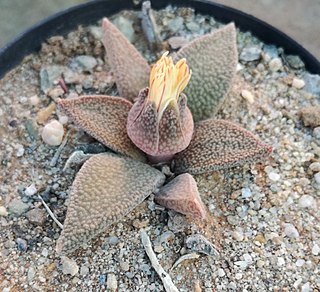
Haworthia is a large genus of small succulent plants endemic to Southern Africa (Mozambique, Namibia, Lesotho, Eswatini and South Africa).

In botany, succulent plants, also known as succulents, are plants with parts that are thickened, fleshy, and engorged, usually to retain water in arid climates or soil conditions. The word succulent comes from the Latin word sucus, meaning "juice" or "sap".

Haworthia truncata, locally known as horse's teeth, is a species of succulent plant in the genus Haworthia. It is found in the Little Karoo region, in the far east of the Western Cape Province, South Africa.

Haworthia magnifica is a species of the genus Haworthia belonging to the family Asphodelaceae.

Haworthia retusa is a species of flowering plants of the genus Haworthia in the family Asphodelaceae, endemic to a very small area around Riversdale, in the Western Cape Province in South Africa. Growing to 10 cm (3.9 in) tall and broad, it is a perennial succulent with thick triangular leaves and small white tubular flowers held in 50 cm (20 in) tall racemes.

Haworthiopsis pungens, formerly Haworthia pungens, is a species of flowering succulent plant from the Eastern Cape Province, South Africa.

Haworthia decipiens ("Papierrosie") is a species of Haworthia, in the family Asphodelaceae, in the Western Cape and Eastern Cape Provinces of South Africa.

Tulista pumila ("Vratjiesaalwee") is a species of Tulista succulent plant, from the Western Cape, South Africa.

Tulista kingiana is a species of succulent plant, from the Western Cape, South Africa. It is listed as Endangered on the IUCN global Red List

Haworthiopsis is a genus of succulent plants in the subfamily Asphodeloideae. The genus was previously included in Haworthia. Species in the genus are typically short perennial plants, with leaves often arranged in a rosette and frequently having raised white markings. The two-lipped flowers are borne on a tall stalk and are small – less than 17 mm (0.7 in) long – and pale in colour. Many species are cultivated as house plants or by succulent enthusiasts.

Haworthia parksiana is a species of succulent plant native to the Western Cape of South Africa. Regarded as the smallest and one of the rarest types of Haworthia in the wild, it is thought to be most closely related to Haworthia floribunda. It grows in rosettes up to about 4 centimetres (1.6 in) in diameter, and is often hidden in the ground.

Aloe haworthioides is a species of plant in the genus Aloe native to Madagascar. This aloe is named for its leaves covered with soft spines and thus its resemblance to Haworthia species. A small species, it grows in stemless, clumping offsets and sports orange, highly fragrant flowers.

Haworthia mutica is a species of succulent plant native to South Africa's Cape Province. Very similar to, and often confused with, types such as Haworthia retusa, the species has blunt, triangular shaped leaves that are typically striated. In the wild it rarely offsets, though clones in cultivation may do so readily. The variety H. mutica var nigra is similar but with darker leaf color.

Haworthia chloracantha is a species of succulent plant native to the Cape Province of South Africa. H. chloracantha has typically pale yellow-green leaves and is somewhat similar to Haworthia reticulata in form, but the leaves are opaque rather than translucent. It forms prolific clusters of plants. The plant has a few subvarieties including var. denticulifera, meaning has small teeth on its leaves, and var. subglauca, which has darker foliage.

Haworthia floribunda is a species of succulent plant in the genus Haworthia native to the Cape Province of South Africa. It grows in rosettes with dark green, lanceolate leaves that curve or twist outward. The leaves may be smooth or, in H. floribunda var dentata, have small teeth.

Haworthia herbacea is a species of succulent plant in the genus Haworthia native to the Cape Province of South Africa. Closely related to Haworthia reticulata, it has greenish yellow leaves with small spines. As it matures the leaves get darker green and the white spots raise. Flowers by way of a shoot and produces a large off-white flower.

Cheiridopsis peculiaris is a species of succulent plant in the genus Cheiridopsis native to South Africa. Its name refers to the peculiar leaf shape compared to other species in its genus. Like other Cheiridopsis it has leaf pairs, but unusually the outer pair grows flat along the ground while the other pair faces toward the sky.

Aloinopsis rubrolineata is a species of succulent plant in the genus Aloinopsis native to South Africa. It grows in a branching habit low to the ground, and has leaves covered with small, round tubercles. The leaves are dark olive green and tongue-like in shape. Its scentific name refers to its flowers, which have a distinctive red stripe.

Crassula namaquensis is a species of succulent plant in the genus Crassula native to South Africa. Easily confused with some forms of Crassula tecta and Crassula sericea, this species has rounded to elongated leaves that are usually blue, covered in fine hairs, and form clumps.

Haworthia reticulata is a species of succulent plant native to the southwestern Cape Provinces of South Africa. The species has several varieties, including var. hurlingii which is the smallest at up to 1 inch (2.5 cm) wide.





















